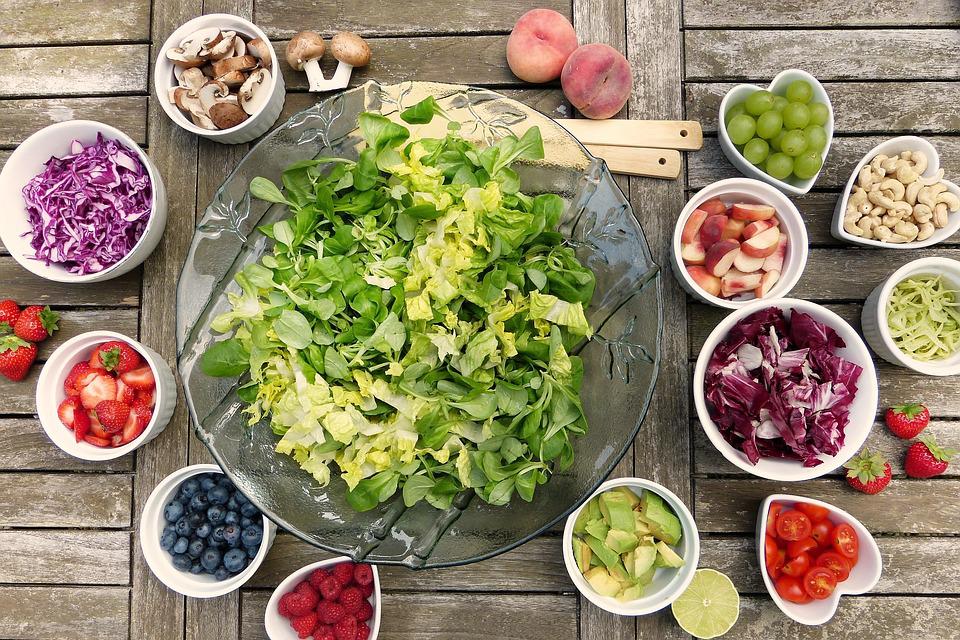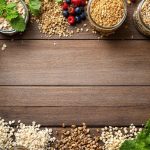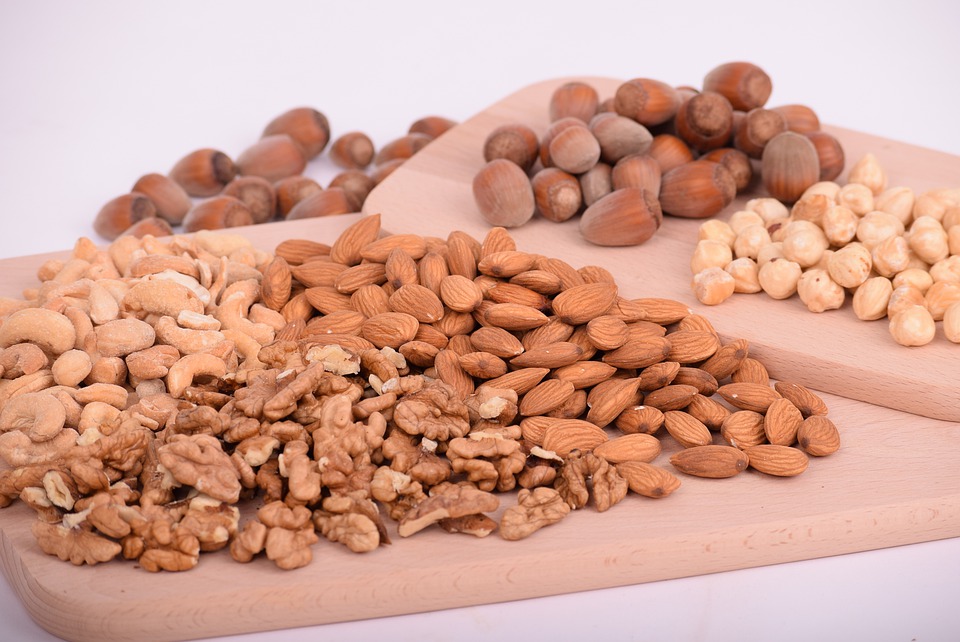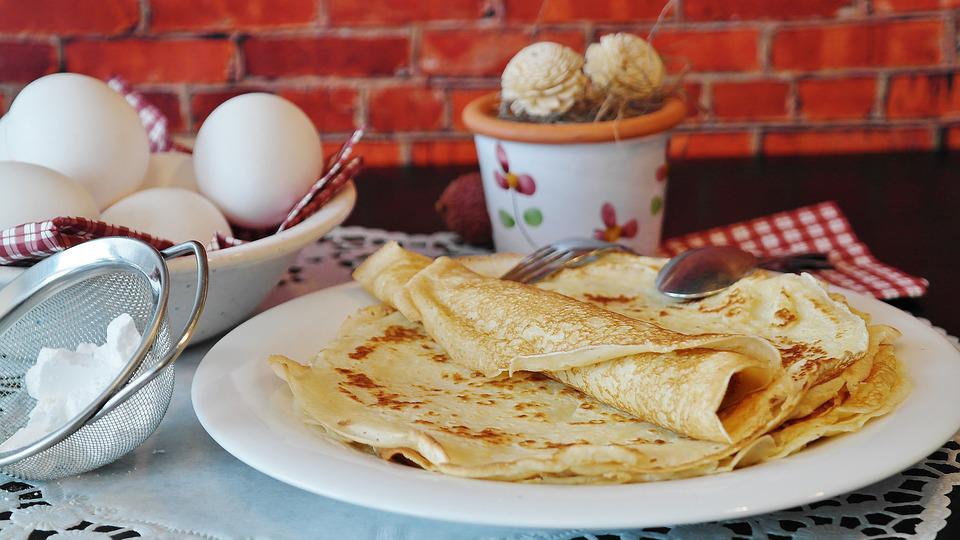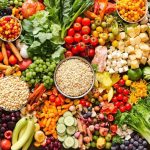Incorporating whole grains into your daily diet can be simple and delicious. Start your day with whole grain toast topped with avocado or nut butter, or enjoy a quinoa breakfast bowl with fruits and nuts. At meals, swap refined grains for whole grains by choosing brown rice over white rice, whole grain bread over refined bread, and whole grain pasta over regular pasta. For snacks, opt for whole grain crackers with hummus or air-popped popcorn seasoned with herbs. By making these easy swaps, you’ll be on your way to a healthier diet—and there are even more ways to boost your whole grain intake.
Key Points
- Start with Whole Grain Breakfasts: Begin the day with whole grain toast, oat-based pancakes, or quinoa breakfast bowls for a nutritious start.
- Swap Refined Grains for Whole Grains: Replace white rice with brown rice, white bread with whole grain bread, and regular pasta with whole grain pasta to boost fiber intake.
- Incorporate Whole Grains into Salads and Soups: Use quinoa, brown rice, or farro as base ingredients and mix with vegetables for hearty meals.
- Choose Whole Grain Snacks: Opt for whole grain crackers with hummus, air-popped popcorn, or homemade energy balls from oats and nut butter for nutritious snacks.
- Prioritize Whole Grain Products: Look for products labeled “100% whole grain” and ensure whole grain ingredients are listed first to maximize health benefits.
Simple Breakfast Ideas With Whole Grains
You can also try whole grain toast topped with avocado or nut butter for a nutritious and satisfying option rich in healthy fats and essential nutrients.
Another versatile whole grain to contemplate is quinoa. Cook quinoa in milk or water and add fruits and nuts for a protein-packed start to your day.
If you’re looking for something a bit more indulgent, experiment with whole grain pancakes or waffles made from whole wheat flour or oats. These offer a delicious and nutritious alternative to traditional recipes.
Additionally, you can boost your fiber intake by adding oats or bran to your breakfast smoothie, making for a quick and convenient meal option that still packs a nutritional punch.
Swapping Refined Grains for Whole Grains
Shifting to whole grains can greatly enhance your dietary fiber intake and nutrient density, making it a simple yet impactful step towards a healthier lifestyle. By swapping refined grains for whole grains, you’re not only boosting the nutritional value of your meals but also supporting better digestive health.
Start by replacing white rice with brown rice or quinoa in your meals. This small change increases your fiber intake and provides more vitamins and minerals.
Next, swap out refined white bread for whole grain bread. This not only adds fiber but also brings in a wealth of other nutrients like B vitamins and iron.
Substitute regular pasta with whole grain pasta to enhance dietary fiber, which aids in healthier digestion.
Even your snacks can benefit from whole grains; choose whole grain crackers over processed varieties.
Finally, incorporate oats into your breakfast by replacing sugary cereals with plain oats, which are lower in sugar and higher in nutrients.
These simple swaps can make a big difference in your overall health.
Whole Grain Salads and Soups
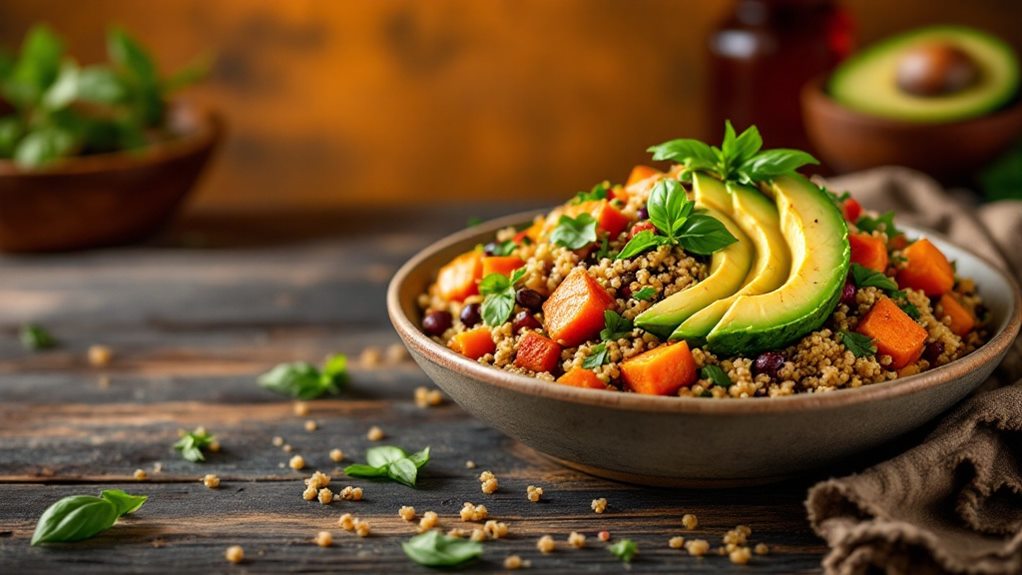
You can easily incorporate whole grains into your daily meals by making them the base of your salads and soups.
Try mixing cooked whole grains like quinoa, brown rice, or farro with fresh vegetables, herbs, and a light vinaigrette for a nutritious salad, or blend them into creamy soups for a satisfying and hearty meal.
Grain Salad Ideas
Exploring Whole Grain Salad Ideas
When it comes to incorporating whole grains into your diet, grain salads are a versatile and nutritious option. By choosing a variety of whole grains, you can create a range of salads that cater to different tastes and dietary needs.
Key Whole Grains for Salads:
- *Quinoa*: A complete protein with a nutty flavor, perfect for adding a protein-rich base to your salads.
- *Brown Rice*: Offers a chewy texture and is rich in fiber, promoting fullness and supporting digestive health.
- *Barley*: High in fiber with a nutty flavor, contributing to heart health and enhancing the nutritional profile of your salads.
- *Bulgur*: Quick to cook, a source of B vitamins and minerals, making it a great choice for creating a nutrient-dense dish.
Seasonal Grain Options
Seasonal variations in grain salads and soups offer a world of possibilities for incorporating whole grains into your daily meals. By choosing seasonal vegetables and whole grains like quinoa or farro, you can create nutritious and filling options that are high in protein and fiber.
| Season | Whole Grains | Seasonal Vegetables |
|---|---|---|
| Spring | Quinoa, Barley | Asparagus, Spinach |
| Summer | Farro, Brown Rice | Sweet Corn, Tomatoes |
| Autumn | Bulgur, Millet | Roasted Butternut Squash, Carrots |
| Winter | Spelt, Wild Rice | Root Vegetables, Kale |
| Anytime | Rye, Wheat Berries | Leafy Greens, Cruciferous Vegetables |
Incorporating these seasonal options into your whole grain salads and soups can enhance flavor and add vitamins and minerals. For example, quinoa salads with fresh herbs and vegetables can be light and invigorating in the spring and summer, while barley soups with roasted root vegetables can provide a hearty and satisfying meal in the autumn and winter. By exploring these seasonal grain options, you can diversify your nutrient intake and keep your meals interesting throughout the year.
Preparation and Tips
Crafting the perfect whole grain salad or soup starts with a solid foundation – cooked grains that provide a rich source of fiber and essential nutrients. By incorporating whole grains like quinoa, barley, or brown rice into your salads and soups, you’re not only boosting the fiber content but also adding essential vitamins and minerals that promote overall health.
When preparing whole grain salads and soups, consider these key tips:
- Diversify Your Grains: Experiment with a variety of whole grains such as quinoa, barley, farro, and bulgur to add different textures and nutritional benefits.
- Add Colorful Vegetables: Include a mix of colorful vegetables like bell peppers, carrots, and spinach to increase vitamin intake and create visually appealing dishes.
- Enrich with Legumes: Add legumes like beans or lentils to your soups to enhance protein and fiber content, promoting satiety and digestive health.
- Homemade Dressings: Opt for homemade dressings using olive oil, vinegar, or lemon juice to avoid added sugars and preservatives found in store-bought dressings, enhancing the nutritional profile of your whole grain salads.
Easy Whole Grain Substitutions
By switching to whole grains, you’ll boost your dietary fiber and essential nutrient intake. Here’s how you can do it:
| Current Choice | Whole Grain Substitute |
|---|---|
| White Rice | Brown Rice or Quinoa |
| White Bread | Whole Grain Bread |
| Refined Pasta | Whole Grain Pasta |
| Sugary Cereals | Whole Grain Cereals or Oats |
Choose whole grain bread for sandwiches and toast, replacing refined options. For pasta dishes, opt for whole grain pasta for more fiber and nutrients. Breakfasts become healthier with whole grain cereals or oats, providing better satiety and essential vitamins and minerals. Even snacking can be healthier with whole grain crackers, perfect for enjoying with your favorite dips. By making these substitutions, you’ll enhance the nutritional value of your meals without sacrificing flavor or texture.
Incorporating Whole Grains Into Snacks
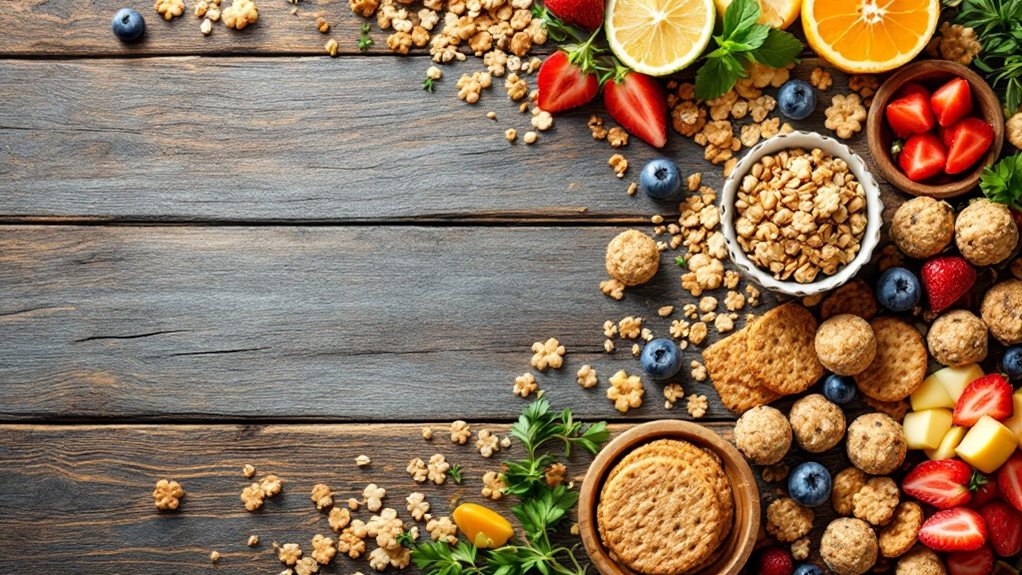
To incorporate whole grains into your snacks, start by making simple switches. Choose whole grain crackers with hummus or guacamole, or enjoy whole grain popcorn seasoned with herbs or spices for a fiber-rich and satisfying snack.
You can also mix whole grain granola or muesli with yogurt or milk, top whole grain rice cakes with nut butter and sliced fruit, or create homemade energy balls from whole grain oats, nut butter, and natural sweeteners.
Healthy Snack Choices
Incorporating whole grains into snacks is a simple yet effective way to boost your daily fiber and nutrient intake. By choosing whole grain options, you’re not only satisfying your hunger but also fueling your body with essential nutrients.
To make healthy snack choices, consider the following whole grain snacks:
- *Whole grain crackers* paired with hummus or nut butter offer a nutritious combination high in fiber and healthy fats.
- *Air-popped popcorn* is a low-calorie, whole grain option that can be seasoned with herbs and spices for added flavor.
- *Whole grain granola or oatmeal bars* with minimal added sugars provide a satisfying and energizing snack that promotes digestive health.
- *Whole grain cereals* like shredded wheat or bran flakes topped with fresh fruit and low-fat milk make for a quick and nutritious snack that boosts fiber intake.
Whole Grain Options
Whole grains can easily become a staple in your daily snack routine, offering a boost in fiber and nutrients. By incorporating whole grains into your snacks, you can enjoy a variety of health benefits, from improved digestive health to increased energy levels.
One of the simplest ways to add more whole grains to your snack routine is by pairing whole grain crackers with hummus. Not only does this combination offer a rich source of fiber, but it also provides essential proteins and healthy fats. Here are some healthy whole grain snack options:
| Whole Grain Snack | Description |
|---|---|
| Whole Grain Crackers with Hummus | Fiber-rich crackers paired with protein-packed hummus for digestive health. |
| Whole Grain Rice Cakes with Nut Butter and Banana | A mix of whole grains, healthy fats, and natural sweetness for a balanced snack. |
| Air-Popped Whole Grain Popcorn | Low-calorie, high-fiber popcorn made from whole grain kernels. |
| Whole Grain Granola or Energy Bars | Opt for bars with whole oats or barley as the primary ingredient for peak nutrition. |
Daily Snacking Tips
Daily snacking often falls into a routine, but by making a few straightforward changes, you can boost your nutrient intake considerably. Incorporating whole grains into your snacks is a simple way to increase your fiber and nutrient intake. Here’s how you can do it:
- Whole grain crackers: Pair whole grain crackers with hummus or cheese for a snack rich in fiber and protein. You can choose store-bought options like Wasa multi-grain crispbreads or make your own using simple recipes[1][2].
- Whole grain oats: Enjoy overnight oats made with whole grain oats, yogurt, and fresh fruit as a convenient and nutritious snack.
- Whole grain granola bars: Opt for whole grain granola bars or energy bites made with oats and nuts to provide a balanced snack rich in fiber and healthy fats.
- Whole grain rice cakes: Top whole grain rice cakes with nut butter and sliced bananas for a satisfying and wholesome snack.
Choosing Whole Grain Breads and Cereals
When choosing cereals, look for products with at least 3 grams of fiber per serving, as higher fiber content is associated with greater health benefits.
Check for the Whole Grains Council’s 100% stamp on cereal packaging, as it guarantees that the product is made entirely from whole grains.
Incorporate whole grain cereals, such as oatmeal or whole grain flakes, into your breakfast routine to greatly contribute to your daily whole grain intake.
Adding Whole Grains to Meals
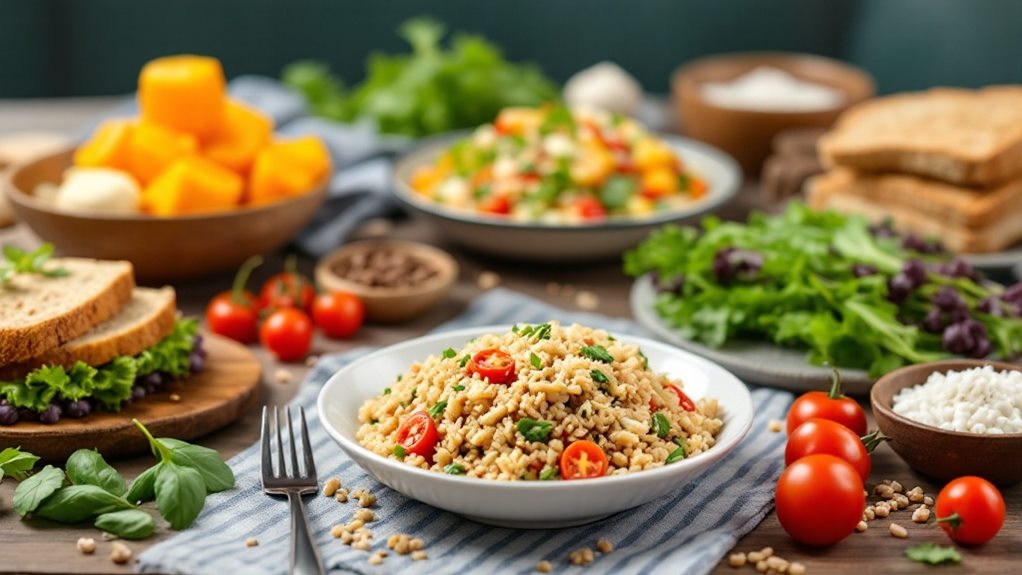
- Start with breakfast: Begin your day with a hearty bowl of porridge made from whole oats. This helps kick-start your metabolism and provides a feeling of fullness that lasts.
- Lunch on whole grains: Opt for wholemeal wraps filled with lean proteins and vegetables for higher fiber intake.
- Dinner with a twist: Incorporate whole grain brown rice or quinoa into your dinner stir-fries or salads to enhance nutrient density and add a nutty flavor.
- Snack smart: Enjoy whole grain crackers paired with hummus for a satisfying and nutritious snack that supports weight management and satiety.
When adding whole grains to your diet, focus on incorporating a variety of whole grain products.
Look for items where a whole grain ingredient is listed first, ensuring you get the full health benefits of whole grains.
Whole Grain Grocery Shopping Tips
Grocery shopping for whole grains requires a keen eye for detail to confirm you’re picking up the most nutritious options. When browsing through the aisles, prioritize products labeled “100% whole grain” or have “whole grain” as the first ingredient on the label. This guarantees you’re getting the full nutritional benefits of whole grains.
Be cautious of terms like “multigrain” or “natural,” as they don’t necessarily mean the product is made from whole grains. Checking nutrition labels for high fiber content is also essential. Aim for at least 3 grams of fiber per serving, which indicates a more nutritious whole grain product.
Additionally, familiarize yourself with the Whole Grain Council’s stamp. This certification guarantees that the product contains a significant amount of whole grains, confirming quality and authenticity.
Lastly, pay attention to the ingredient list. Avoid products with “enriched flour” or “wheat flour” at the top, as these indicate refined grains rather than whole grains.
Homemade Whole Grain Recipes
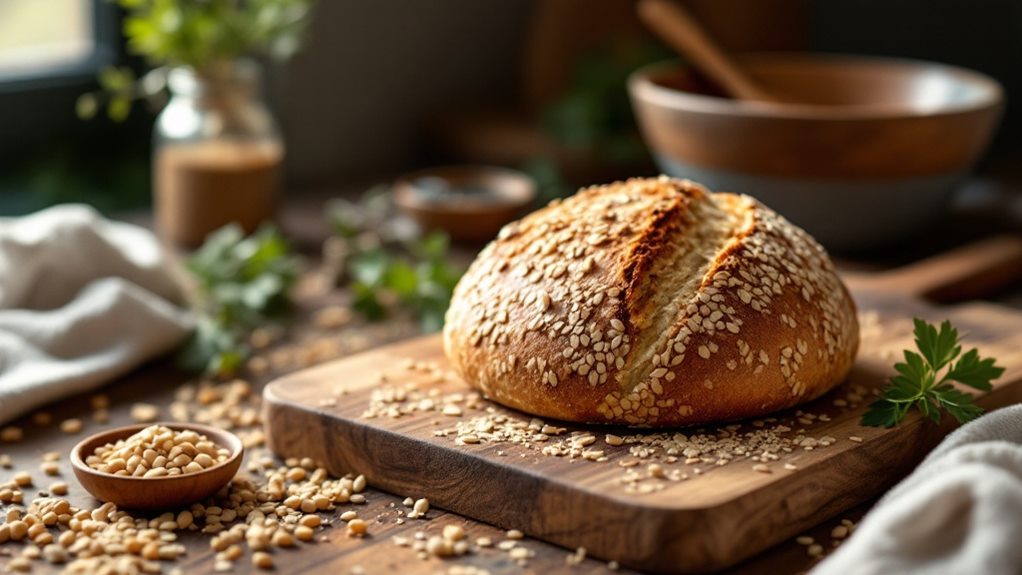
Incorporating whole grains into your diet doesn’t have to be overwhelming. Start by making simple and delicious homemade whole grain recipes that can elevate your meals and provide numerous health benefits.
Key Homemade Whole Grain Recipes:
- Hearty Porridge: Begin your day with a hearty porridge made from steel-cut oats, topped with fresh fruits and nuts for added nutrition and a satisfying breakfast.
- Quinoa Salad: Prepare a quinoa salad with diced vegetables, herbs, and a light vinaigrette to enjoy a protein-rich, gluten-free meal packed with essential nutrients.
- Whole Grain Bread: Create homemade whole grain bread using whole wheat flour, which retains the bran and germ for maximum fiber and nutrients, ensuring a healthier alternative to store-bought options.
- Stir-Fry with Brown Rice: Whip up a stir-fry featuring brown rice or millet, loaded with colorful vegetables and lean protein, for a quick and satisfying dinner that highlights whole grains.
In Summary
You’re about to open up a world of health benefits by incorporating whole grains into your daily meals. Start by making simple switches: swap white bread for 100% whole wheat, brown rice for white rice, and whole grain pasta for refined. Experiment with quinoa salads, barley soups, and oatmeal for breakfast. For snacks, try popcorn or whole grain crackers. The possibilities are endless – literally a million ways to make whole grains a part of your life.


